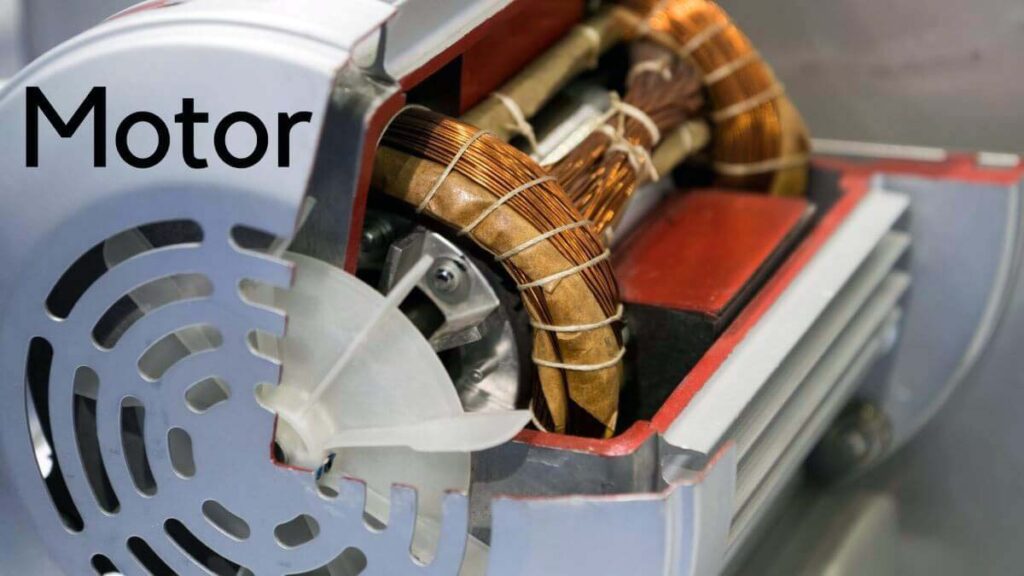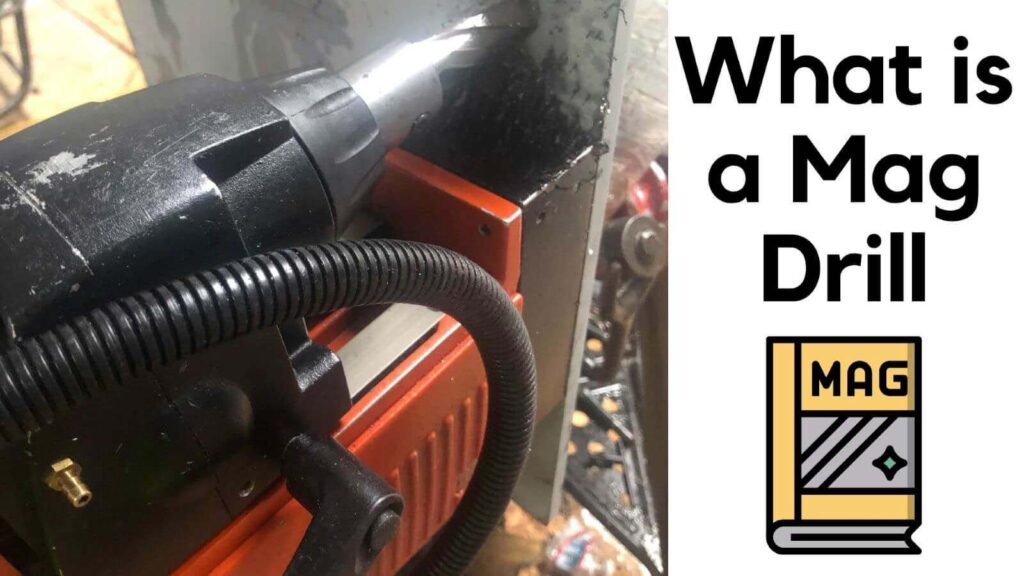A magnetic drill is a specialized portable power tool used to drill holes in steel and other similar metals and other materials.
A magnetic drill, known as a mag drill, is used to cut through metal. A magnetic base, a drill stand, a motor, and an arbor or chuck are the four main parts of a magnetic drill.
Mag drills can be used with various tools, including annular cutters, twist drills, taps, reamers, and countersinks.
A magnetic drill’s convenience cannot be understated.
I-beams, truck beds, stationary metal pieces, and so forth necessitate the use of a magnetic drill press, just as a countertop or standing drill press. The magnetic base stabilizes the drill to cut the material, which attaches to the metal surface. Don’t even think about using a non-magnetic drill press for this purpose.
Table of Contents
When Should I Make Use of a Mag Drill?

It might take a long time and a lot of effort to move massive steel or pipe into place at a stationary drill press or work centre.
Instead of getting the drill to the workpiece, a portable magnetic drill allows you to bring the drill to the workpiece.
Using a portable magnetic drill in any position is possible, including vertical, horizontal, and overhead (upside down)
Why Should You Use a Magnetic Drill Press?

When you need to drill with accuracy and consistency, a magnetic drill can provide you with the precision and speed you need.
When activated, magnetic drills have a strong electromagnetic foundation that allows them to adhere to the surface of carbon steel (ferrous metal) when drilling. Magnetic drills may be used to drill horizontally, vertically, or overhead, particularly beneficial in the construction industry.
To avoid falls from great heights or into your head, make sure to anchor your mag drill to the surface being drilled into, especially when working overhead.
Read More: How to Drill a Hole Bigger than Your Drill Bit?
The History of the Magnetic Drill Press
“Magnetic drills were initially developed to allow construction companies to drill many holes in pre-installed structural steel, such as i-beams.
They give more excellent stability and convenience of operation than a handheld drill, greater precision, and a faster cutting rate of large diameter holes.
A further advantage of mag drills is their ability to drill and tap (thread) holes up to 1-5/8′′ in diameter (40mm). For instance, a popular application is drilling a 9/16″ (14mm) diameter hole without moving the machine to tap a 5/8″ (16mm) thread.”
Read More: How Long Does it Take to Charge a Drill Battery?
Magnetic Drill Press Types:
- On most job sites, where electricity is readily available and the work environment is relatively dry, electric magnetic drill presses are recommended.
- Pneumatic magnetic drill presses for damp or hazardous job sites when access to a compressor is necessary.
- Magnetic drill presses are hydraulic drill presses that are primarily utilized in industrial, construction, and marine drilling applications.
How to Using a Magnetic Drill Press
- For the electromagnet to work, the material foundation must be ferrous metal.
- You can’t use a magnet on a piece of metal that isn’t flat and clean.
- Keep the bottom of the drill clean as well.
- A safety chain should be used to keep the drill press in place, as it will fall over if the power goes out.
Check Also: 10 Cross Slide Drill Press Vise You’ll Love.
What is the Purpose of a Mag Drill?
- Building & Construction
- Steel Fabrication
- Mining
- Bridge Rebuilding
- Truck, RV & Special Vehicle Build
- Ship Building
- Welding Shops
- Pipeline, Offshore & Oil Fields
- Railroad Industries
- Power Utilities
- Mobile Repair Shops
- Machinery Riggers
- Maintenance Facilities
Read More: How to Drill a Hole in Plastic Without a Drill?
Design of a Magnetic Drill Press
A magnetic drill press comprises four main components: a magnetic base, a drill stand, a motor, and an arbor.
Base Magnetic
A magnetic drill press’s base is equipped with a powerful electromagnet that enables the machine to be readily clamped (adhered) to the workpiece to be drilled.
When charged, this magnet bonds securely to the workpiece, securing the machine base to the metal workpiece and allowing the operator to feed the workpiece steadily.
The electromagnet is critical in a portable magnetic drill press. It keeps the machine stable, prevents the engine from dismounting while drilling, and allows for work with the machine overhead, horizontally, or vertically.
While a magnetic drill press is typically used on ferrous materials directly, it can also be used on non-ferrous materials such as stainless steel when clamping devices are utilized.
Read More: What is Drill Press Swing
Drilling Platform
A drill stand is the primary body of the magnetic drill press. It houses the electric switches for the motor and magnet and the magnetic indicator and PCBs.
The magnetic drill press’s body encases the motor and magnetic base. Additionally, the feed handle is linked to the body.
The magnetic drill press’s body aids in the motor’s upward and downward feed. The body of the magnetic drill press also serves as a grip for lifting and moving the equipment. The body is typically made of cast iron.
Motor

A magnetic drill press’s primary component is the motor. It is a direct current motor. The motor’s output power ranges from 800 to 2300 watts, depending on the amount of energy necessary for drilling. A wider diameter hole will necessitate a more potent motor.
Additionally, the motor used in drilling and tapping machines will support both clockwise and anti-clockwise spinning. In most cases, the motor’s electronics for speed and torque control are integrated.
Arbor
An arbor, also known as a tool holder or chuck, is attached to the motor on a magnetic drill press. It is a particular sort of clamp used to secure core drills.
There are primarily two types of chucks available for the magnetic drill press: industrial arbor (manual tightening) and quick change drill chucks.
Quick-change drill chucks are a convenient and quick way to attach core drills. They are not required to tighten the screws/jaws physically. Arbors and chucks come in various spindle holder (machine taper) configurations, including Morse taper MT 2, MT 3, and MT 4. The chuck accepts a variety of core drill shafts (shanks).
Cutting Tools in Magnetic Drills
The most common cutting tool is an annular cutter when drilling through steel with a magnetic drill. An annular cutter is a type of end mill with a hollow core to cut holes in metal. For the magnetic drill press to stick to the surface, the steel must be at least 1/4′′ thick – preferably 1/2′′ thick.
A Magnetic Drill Press With Core Cutting

The magnetic drill press is essential when cutting or drilling holes in steel. You can align and secure your drill, which will alleviate some of the strain on your body when hitting. Invest in a mag drill with a swivel base if your budget allows. This simplifies the process of aligning the training above the hole.
The annular core cutters from Walter Surface Technologies are guaranteed to outperform all uncoated blades.
Walter annular core cutters are constructed of specially formulated high-speed steel (HSS) with a distinctive state-of-the-art coating that keeps them cool and extends their life! Walter’s patented tooth design resists breaking, and the ICE CUT range of annular cutters is engineered to outperform in environments where lubricants are prohibited.
ANNULAR CORE CUTTERS ICECUT™with Weldon Shank
The annular cutters of the Walter ICE CUT series are coated with a unique alloy of chromium and aluminium (AICrN). These annular cutters are used in areas where lubricants are not permitted or have complex applications.
This AICrN technology outperforms blades of Titanium (TiN) or Titanium-Aluminum (TiAIN). Walter ICE CUT annular cutters can tolerate temperatures up to 200 degrees Celsius higher and generate less heat than standard TiAIN cutters due to incorporating the chromium aluminium blend into the coating. The AICrN coating on the ICE CUT is resistant to increased stress under load and immediate impact.

Hey, I am Shihab Uddin, I’m a huge fan of DIY crafts. My workshop is where I spend most of my spare time, and I’m always working on some project. To that end, I’d like to share some of my knowledge and experience with you in power tools, woodworking, and other specialized materials fabrication.
I will guide you with genuine knowledge that can assist you with deciding whether a drill is appropriate according to your requirements or not. If you want to find the best drill and know which type of drill is most suited for your needs, then I can guide you with my expertise. My passion lies in helping others find the correct products they need at an affordable price.


